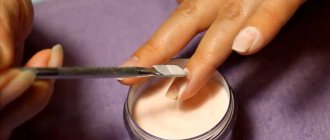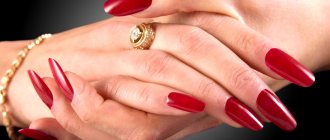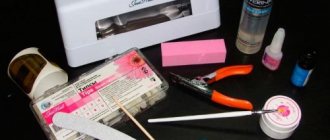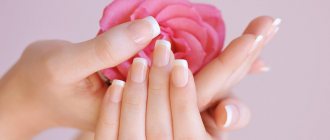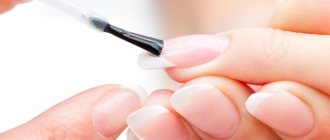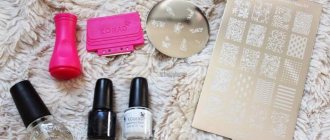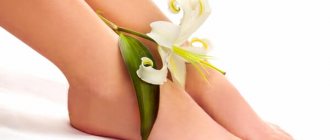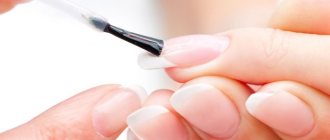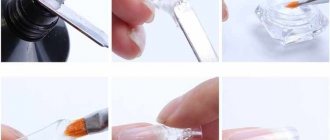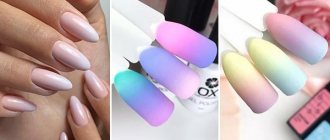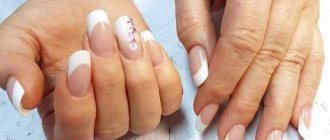Beautiful hands will never go out of fashion, which means that mastering the art of manicure will not only save you from the need to visit salons, but will also bring tangible profits. Have you long wanted to learn the art of nail extensions, but didn't know where to start? Where to find a decent teacher, will you succeed? There are probably a lot of questions floating around in your head that you can’t answer yet. In this article we will try to tell you in as much detail as possible how to learn how to do nail extensions, what form of presenting information to choose, what are the pros and cons of each method.
Variety of gels for nail extensions
There is a wide range of gels for nail extensions at home. They exist in transparent or camouflage form, with shades of pink or beige, stained glass and color.
All gels differ in a specific extension scheme:
- Single-phase: contain base, modeling and protective compounds. Easy to apply to the nail. The consistency is liquid. Best used by beginners.
- Two-phase: the consistency is the densest. When applying them, 2 products are used separately - the first main layer and the second sculptural one.
- Three-phase: when using them, layers are applied in 3 stages - initial, sculptural and protective. The third of them ensures the preservation of the nail for a longer time. Widely used by experienced craftsmen.
There are a lot of manufacturers of nail extension gels that can be used independently.
The most popular of them:
- Gel IBD. Made in USA. Does not provoke the development of allergies, acid-free, no pain during drying, neutral odor. It consists of natural ingredients, which protects the nail and also nourishes it. There are no problems with application. This manufacturer produces various types of gels. One of them is IBD Bonder Gel: not thick, self-leveling, hardens under a lamp in 60 seconds. The structure of the nail does not deteriorate, it is able to adhere firmly to the surface, and the nails do not turn yellow. Price 800 rub. Volume 14 ml.
For gel nail extensions at home, it is recommended to use only high-quality materials, for example, IBD - Gel Formula Profi. Russian manufacturer. Among the range produced by the manufacturer is the Formula Profi gel base. Cost 590 rub. Liquid, adheres well to the nail surface. Under a UV lamp it hardens in about 2 minutes.
- Gel All Season. Made in USA. Among its products it is worth highlighting: Shimmer Gel from All Season. Cost 1210 rub. Volume 28 g. Contains silver glitter. Used as layers applied in the second or third stage. Dries in 2 minutes.
- Gel Runail. Made in Russia. Among the products we can note a transparent gel with an orange tint. Cost 205 rub. Volume 7.5 g. Increased viscosity, dries in 1 minute.
- Gel Global. Made in USA. Our products include single-phase and three-phase gels. Global gel sets (12 pcs.) are also offered. Cost 1,500 rub. There are several different colors in the jars.
Minimum required set of tools and materials for gel extensions
Today, manufacturers of nail care products regularly supply products to the market, which makes it easier for you to find the necessary materials and tools for extensions. Among them are the following:
- UV lamp. Used to dry the gel. If possible, choose a lamp with a built-in timer so that you can adjust the time for the gel to cure.
- Gel. Most often, extensions are made with transparent or camouflage gel, but if necessary, you can purchase colored ones.
- Application brush made of artificial bristles. As a rule, it should be flat.
- Sticky layer remover. Must be used after irradiation in a UV lamp.
- Primer (degreaser). With its help, the nail plate adheres to the gel.
- Forms for laying out the gel. Used as a substrate.
- Tips. Glue over natural nails. Recommended for use in extensions by beginning craftswomen.
- Glue. Used for gluing tips or any decorative details on extended nails.
- Tip cutter. Allows you to get rid of unwanted length.
- Gel coating (finish or top coat). A transparent coating that is applied at the end of the extension. Adds shine and ensures design fixation.
- A set of files of different hardness.
- Polishing file (buff).
- Disinfectant.
Materials and tools in the photo.
Extension techniques
Gel nail extensions at home will come to the rescue when it is impossible to grow your own nails.
There are several methods:
1. With tips . It is based on fixing the tips with special glue. They are produced in a wide variety of sizes and shapes. They can be white, transparent or colored. After the gluing stage, the tips are filed to create the required length and shape. Then begins the stage of distributing the gel or acrylic, which is polished after application. If necessary, you can apply a drawing on top.
The advantages of this extension include:
- less painstaking work than on forms;
- extension takes less time;
- more suitable for people with large fingertips;
- good for brittle nails.
Among the disadvantages of this method it is worth noting:
- nails look less neat;
- tips do not allow you to create some forms;
- cannot be pressed, which makes them very thick;
- will make the wide nail plate wider.
2. On forms. There are 2 types: disposable paper and durable metal. First, the form is attached to the edge of the nail, which is free, and then covered with material. When the applied composition has dried, the mold is removed and the length is formed with a file. Then the nail is polished and secured with a product.
Advantages of using forms:
- nails look more natural in appearance;
- It is possible to give the nail plates a variety of shapes.
Flaws:
- duration of the process;
- the price is much higher.
Also, nail extension methods are divided depending on the material:
1. With acrylic. This material dries quickly, so it is necessary to develop a certain skill in working with it.
The advantages of extensions using acrylic are:
- strength, can last up to a month;
- look natural.
The disadvantages of acrylic coating are:
- pungent and unpleasant odor;
- worsens the condition of the nail.
2. Gel extensions. More than half of the gel consists of pine tree resin. Dry only under a UV lamp.
The advantages of this extension include:
- environmental friendliness of the material;
- air and moisture permeability, so your own nails do not deteriorate;
- it is possible to create a variety of beautiful drawings;
- the lamp prevents the spread of fungal diseases.
Among the disadvantages are:
- fragility;
- a damaged nail cannot be corrected.
Varieties
Today, two types of upper forms are known. Depending on the cost, they can be either with or without markings to facilitate the work process. The first option is especially convenient for beginners who are getting acquainted with nail extensions using such templates.
The markings on the forms may differ; in some places they are arched stripes, in others they are a grid.
The set has the same arch and length, as well as markings with the indicated dimensions. Based on the marking lines, it is easier to align the length and adjust the edge. There is no need to tediously adjust an identical shape, since it already exists.
Read also: Logic problems for children 10-14 years old
The upper forms are classified as reusable types of extension templates. They differ from arched counterparts and liquid tips.
Rules for choosing a nail extension method
Gel nail extensions at home can be done using several methods.
There are many reasons that influence the choice of the appropriate method, for example, the shape of the natural nail:
- Normal - almond-shaped. Any method can be applied to them.
- Springboard-shaped are characterized by a small nail plate. Here it is worth choosing tips. They need to be taken with a more formed arch, with a bend and not a wide area for contact.
- Flat nails . Both methods can be used.
- Nails growing downwards. The most suitable method is using forms.
- Bitten nails. For this type, the most suitable are tips that have a small area for connection.
What are gel extensions?
Learning how to do nail extensions is a profitable business, as lessons can be obtained online for free. And when you do it professionally, you can save significantly on the services of salon specialists. In addition, your skills will certainly be successful and popular with your friends, who will also want to get the perfect manicure without visiting a salon.
French extension
Before you start learning how to do gel nail extensions, it is important to understand what it actually is. There are two main categories. They differ in the technology of performing the procedure and some operational characteristics.
- Extension of French manicure on gel tips is shown step by step in the video. The main difference is that, in fact, an artificial nail is glued directly onto the bed, onto which the gel is then applied. The method is convenient because it can be applied even to very short natural nails. In addition, it can be made into much longer lengths or varied shapes. Removing a manicure on nail tips is quite difficult;
- The process, procedure and technique of gel nail extensions on forms are presented in the following video. In this case, small plates are glued to the stock. The gel is applied to them and the protruding part of its own bed. Such nails can be easily removed even on their own, but they hold well and do not break. The manicure looks more natural after this procedure.
https://www.youtube.com/watch?v=YvIq_e1-M9I
Regardless of which gel nail extension technology is used in each specific case, the procedure for removing such beauty is very complicated. Especially compared to acrylic extensions. In fact, the gel is cut off from the bed with a rough file or a special machine. This can seriously damage the nail plate.
Nails on forms: what you need
Performing a manicure requires the presence of certain items:
- extension forms;
- Ultraviolet lamp;
- brushes for distributing gel;
- modeling gel;
- primer;
- degreaser;
- nail files and buffer to shape and smooth the surface of the nails;
- fixative;
- scraper (pusher);
- disinfectant solution;
- a product that removes sticky layers;
- lint-free wipes;
- cuticle softening oil.
Using tips
Gel nail extensions at home using tips requires the following to be available:
- a product that softens the cuticle;
- scraper;
- file and polisher (buff) for nails;
- tips;
- type cutter;
- glue for gluing tips;
- gel;
- Ultraviolet lamp;
- brushes for applying gel;
- a product that removes the adhering layer;
- lint-free wipes;
- disinfectant;
- primer (promotes better attachment of natural nails and gel);
- nail-trap (a product that prepares the nail for applying gel);
- a product for removing excess oil from nails;
- cuticle oil.
Classification of nail forms
Nails can be given different shapes:
- square - look good on long fingers. Their corners are not rounded. They are considered the simplest to implement;
- oval - the edge of the nail reflects the cuticle. They are oval in shape and have no corners. More suitable for narrow and wide plates;
- squawval – oval-square shape. There are formed corners and a slightly rounded edge that does not show the cuticle area;
- almond-shaped – there are no corners, the edges are rounded at the ends more than the cuticle line;
- stiletto - an acute angle without rounding is formed in the center of the edge.
Don't miss the most popular article in the section: How to extend nails with gel polish. Nail extension instructions for beginners. Photo.
Preparatory process
Gel nail extensions at home involve preparatory measures. Such preparation will allow for better quality extensions, avoiding nail fragility, detachment and infection.
This preparation includes several stages:
- Hands are washed and treated with the product.
- The cuticle is softened with a softening agent. It is rubbed into all fingers. Next, the cuticle is pushed back with a scraper.
- Give the required shape to the nail plates.
- Nail plates are polished with files with an abrasiveness of at least 240 units. Polishing is done in the direction of nail growth. Dust is removed with a brush. Then disinfection is carried out with special means. They come in the form of a spray, liquid solution or wipes. Such preparation is sufficient for high-quality extensions.
Necessary materials and tools for acrylic extensions
All products and materials necessary for acrylic extensions are purchased in most cosmetic departments in supermarkets and in specialized manicure stores. To extend nails using acrylic you will need the following tools:
- acrylic for nail extension, which is sold in the form of powder,
- liquid or monomer for acrylic,
- special brush,
- tips,
- acrylic primer,
- type boat,
- orange wood sticks,
- files and a block to polish the nail plates.
Many stores sell ready-made nail extension kits, which eliminate the need to assemble tools separately.
Stages of self-building
During gel extensions, the following actions are performed:
- Hands are treated with antiseptic.
- The cuticle and pterygium (film on the nail surface) are removed.
- Use a file to form the outer edge of the nail and remove the gloss from its surface using a buff (a file in the form of a bar). The length of the nails should be at least half a centimeter to fix the shape.
- Brush off the dust.
- Remove traces of fat with a dehydrator.
- Distribute the primer - adhesive agent.
- Distribute the initial layer of gel, the thickness of which should be no more than 3 mm. Then dry for 3 minutes. under the lamp.
- Fix the form. To attach a paper form you must:
- remove the middle and glue it from the inside to the area where the material will be applied;
- make an oval shape;
- a more twisted shape will make it easier to fix;
- attach the form so that it is a continuation of the nail;
- wrap your ears around your finger;
- the edge of the nail should be cylindrical, corresponding in diameter and size of the nail.
For a high-quality result, it is necessary to secure the form so that there is no space between them. Otherwise, leakage of materials will occur, which will make the thickness greater.
The gel should be applied in a certain sequence: first 4 fingers on one hand, then 4 fingers on the other hand and finally the thumbs.
Creating a gel nail. The shape and nail are divided into zones:
- cuticle area - a third of your own nail;
- the contact zone between the nail and the form is 2/3 of the nail plate, a third of the form is the stress zone. It bears the heaviest load;
- the rest of the form area.
A thin layer of gel must be applied to the cuticle area. The thickness of the gel application becomes greater as you approach the stress zone. The contact area must be covered with the most generous amount of gel. The outer edge is not created by a thick layer of gel. After gel application, drying is carried out under a lamp with UV rays.
- The sticky layer is removed with a special product, and then the nail is filed to level its surface. The file also creates a shape.
- Then the camouflage gel is distributed in 2-3 layers. The layers are dried under a UV lamp.
- Distribution over the surface of the final coating. Hold for 5 minutes. under the lamp.
- The sticky layer is removed.
- The cuticle is moisturized with oil.
Acrylic nail extensions at home
Nail extension with acrylic is a simple procedure, and you can easily give your nails any desired look, but it requires careful preparation, namely, the preliminary purchase of special products and a set of tools for acrylic extension.
Acrylic extensions are made using special frames, which are also called tips. They are attached directly to the nail. Sometimes lower forms can be used as frames, in the form of a metal or paper lining. Using this method, you can make both acrylic and gel coatings. After the materials have dried, the extension forms are removed.
In case of self-extension of nails, it is very difficult to use such forms, since they require constant adjustment, and it will not be possible to move the forms with one hand. Therefore, independent acrylic extensions should be done using tips, the advantage of which is ease of use.
Stages of extension using tips
Gel nail extensions using tips at home are as follows:
- Hands are treated with an antiseptic spray.
- Soften the cuticle and push it back with a pusher.
- Use a degreaser to remove excess fat.
- The outer edge of the nail plate is filed to obtain the shape.
- Use a buff to remove the top layer of the nail. Movements are made in one direction and are carried out until a milky-matte shade is achieved.
- Remove dust with a brush.
- Remove excess fat.
- Select tips that suit the shape of the nail. A number of principles should be followed:
- the width of the tip should be the same as that of your own nail;
- the shape on the outside of the tip should match the inner groove of the nail;
- The plastic nail should completely cover the natural nail.
- Glue the tips to your nails. The glue is distributed with a brush onto the inside of the tip over the entire surface. The tip leans at an angle of 45 degrees. First, it is leaned against the edge of the nail, and then against the surface. Keep pressed for 10 seconds.
- Remove unnecessary length with a tip cutter, leaving a reserve.
- The nail is filed and the border between the nail and the tip is gradually smoothed out so that the line is invisible. The natural nail is not affected. The file should be 100/80 grit. The surface of the nail should be smooth without steps.
- Remove dust with a brush and spread nail prep onto your own nail (a product that will prepare the nail for the distribution of the gel).
- The primer is applied before evaporation.
- Apply a thin layer of gel and dry in a UV lamp for 2-3 minutes.
- The next layer of gel is applied to the contacting part and dried under a lamp. To distribute the gel evenly, keep your hands upside down.
- The sticky layer is removed.
- Use a file to form a shape and polish with a buff. Remove dust with a brush.
- Cover your nails with top coat.
- If you need to make a design.
- The cuticle is lubricated with oil.
Pros and cons of acrylic
The technology of acrylic nail extensions appeared a very long time ago, and therefore, most masters have honed it literally to a shine. Although, sometimes you can hear the opinion that gel extensions are easier, and therefore many novice hairdressers only do it. In many ways, this is a matter of the taste and skills of the master and the wishes of the client. Acrylic extensions, like any other procedure, have a number of pros and cons.
So, the undoubted positive features of acrylic include the fact that it is much stronger than gel. That is why, only when choosing it, it is possible to create a natural thin plate, which is often absent with gel extensions due to the fragility of the material. Most often, acrylic nails with extensions look much more natural.
In addition, gel is much more difficult to remove from nails. Often it only lends itself to mechanical filing, which risks damaging the natural nail. Acrylic successfully dissolves in a special liquid liquid (monomer), which does not have a significant negative effect on natural nails.
Acrylic nail coating can also be applied to long natural nails for the purpose of mechanical strengthening. This procedure is similar to gel strengthening, but is less harmful to nails. In addition, acrylic is more durable, and therefore, when performing corrections, you can go through quite a long time with the same extension or reinforcing layer.
Acrylic nails can be painted with a simple varnish; they do not absorb pigment; however, you should not neglect the protective base. This coating can only be washed using liquid without acetone. If acetone gets on such plates, they will immediately lose their shine.
Among the disadvantages, one can highlight a rather sharp and persistent smell that remains on the nails for quite a long time. As with gel, acrylic nails do not breathe and do not develop a protective layer, and therefore, if you wear the coating for a long time, your own nails can deteriorate. Unlike gel, acrylic cannot be repaired; if a nail is cracked, it has to be removed and rebuilt.
[yandex2] [google2]
Possible mistakes
Incorrect actions when applying nail extensions lead to the material coming off and pockets appearing. These phenomena are associated with incorrect modeling technology or poor nail preparation.
The most frequently made mistakes include:
- the pterygium is poorly removed, which leads to the appearance of pockets. Even the smallest particle of it that gets on the material leads to peeling;
- the nail is excessively filed. This usually happens with a highly abrasive file in the transverse direction. Consequences: soreness of the nail, its thinning and splitting;
- antiseptics and degreasers were not used;
- excessive use of primer, which leads to stratification;
- nails are overdried in the lamp. Nails will peel if kept under the lamp for too long. The material will come off if it gets on the cuticle;
- All c-curves and arches are incorrectly aligned and the apex (the highest point of the nail) is determined. Even a slight thickening will cause detachment. It will change the correct lines of arches and C-curves. Thickening will cause irrational distribution of nail tension forces.
Extended nails require correction at least once every 4 weeks.
French
Gel nail extensions at home can be done using different techniques.
To create a French manicure you will need to follow these steps:
- Determine the future length of the nail. Perform the extension procedure on tips or forms.
- Use a nail file to form the shape of your nail. This determines what the smile line will be like.
- Apply pink gel to the nail and dry under a UV lamp.
- Polish with a file.
- Draw a white stripe with modeling white gel on the free edge of the nail. It is necessary that the antennae be symmetrical, and the transition line be equally curved on all nails. File the edge of the nail.
- Sand the color transition.
- Apply a finishing layer of gel.
Video tutorial on gel extensions:
Of course, you may not succeed the first time, but gradually, by getting better at it, you can become an excellent nail extension artist and make your wildest nail design decisions come true, while making money!
Creating a nail shape using gel forms does not always work out the way you want. Especially for beginners. Don't worry, everything can be fixed with a file!
A file can be used to trim and remove unevenness, giving the nail the desired look.
It is best to start with short square nails, since this shape is easier to do than the rest. As a beginner, you first need to get your hand used to applying the gel and filing it.
To ensure that the gel sticks well to the nail, file off the top layer of the nail plate well and degrease thoroughly!
Editor's choice: Fashionable nail polish spring 2022: how to be stylish and attractive?
Also carefully remove the sticky layer from the gel before applying the next layer.
For a French manicure, it is better to use a stencil, since not everyone can do a French manicure evenly right away.
After you get the hang of creating the shape, you can start designing your nails. For a beginner, it is better to apply all kinds of patterns with a special tool, rather than with a thin brush.
You can first practice on an ordinary tip so that you can apply a neat design to your nail.
In order to build up well, it will take a little time and skill. Practice your skills, watch the video, learn and don’t be afraid!
Shapes of extended nails in the photo:
Plain nails: technique
To beautifully cover your nails with the same color, you need to fill your hand. Step-by-step instructions will help with this.
Stages:
- Disinfect your hands with a special means.
- Degrease your nails with a degreaser.
- Apply primer for better adhesion of the nail to the gel.
- Apply clear gel evenly to the nail.
- Dry your nails in a UV lamp for two minutes.
- Carefully paint the nail plates with colored gel polish.
- Dry your nails under ultraviolet light for 2 minutes.
- Apply another coat if a deeper color is required.
- Dry the second layer for 3 minutes.
- Protect your nails with a fixative.
- Remove the sticky layer using a special product.
A beginner will need about half an hour to do this manicure.
Which gel to choose
The gel extension procedure has more advantages than the acrylic one. The gel is odorless and applies much faster, which is why nail technicians love it so much. The only drawback that may scare you away is the removal method. The gel is only cut off and dried in an ultraviolet lamp. Acrylic sets instantly and is removed with a solvent.
Gel short nails look so natural that they can often be confused with natural ones. This effect can be achieved using camouflage gel, which is represented in a palette of pink shades. It can also be colored or transparent.
Any gel performs the function of a base coat, a modeling tool and a protective surface coating. Thus, its application is carried out in three phases, so it can be one-, two- or three-phase. Each type of gel is applied step by step, which is dried each time in a UV lamp. An overview guide will help you choose the right material:
Single-phase has a three-in-one function. From one jar you can use the gel three times to apply the base, do modeling and give the surface a glossy shine. This is a very economical option
It is important to remember to dry each layer of gel with a lamp. Two-phase consists of two components: base and modeling. In extensions it is used less often than single- or three-phase gel. Three-phase is a set of three components for extensions: base gel, modeling and glossy.
Which type of gel seems more convenient and economical for you is up to you to decide. Experienced nail technicians most often prefer to work with a three-phase system, but if you are a beginner, start with a single-phase system. Gel nails will look good when applied with any material.
Implementation of a combined design
Combined nail designs include various colors and textures:
- the use of two or more shades;
- use of painting, prints and stickers;
- a combination of different textures: matte and glossy, three-dimensional pattern, enamel.
Combined manicure ideas:
- Select 2 nails with lilac polish and paint the rest burgundy.
- Paint 2 nail plates soft pink, paint an ornament on them with black varnish and add rhinestones. Paint the rest burgundy.
- On 2 nails draw a floral print in white and pink tones. On the other nails, paint a pink and white ombre.
- On 2 nails, draw a graphic design in the same color scheme, but with a different structure. Paint the rest of your nails pink.
- Paint your nails with 3 colors of pastel shades: little finger – yellow, ring finger – pink, middle finger – green, index finger – yellow, big finger – pink. At the same time, use a thin white strip to highlight the hole and the outer edge of the nail plate.
Artistic painting
The drawing is applied using varnishes. To do this, use brushes, needles, and toothpicks. It is possible to use rhinestones, sand, and foil.
To create an abstract image on your nails you will need:
- Follow the steps for nail extensions discussed above.
- At the nail design stage: apply the silhouette of a butterfly with white gel, put down a series of dots and draw several curved lines.
- Draw similar components on other nails. They should not repeat the pattern on the ring finger. On the little finger and thumb, draw only dots and wavy lines.
- Take a shade of gel that is close to the main background and draw the leaves of the flower.
- Cover your nails with a sealer.
Designing flowers in an aquarium can be done by following these steps:
- Follow the nail extension steps to design.
- Cover the nail plate to the free edge with red gel.
- Apply the first tier of flowers with pink gel to the outer edge of the nail.
- Apply clear gel to your nails and place under a UV lamp.
- Draw the upper tier of petals with white gel, placing them between the petals of the lower tier. They need to be drawn in more relief.
- Apply transparent gel to nails and dry under a UV lamp.
- Remove the sticky layer and paint the stamens with white paint.
- Decorate the middle of the color with stones.
- Apply a finishing coat to your nails.
Manicure options
In 2022, the following nail design ideas will be fashionable:
- deep dark shades are in fashion: marsala, wine, cherry, dark blue, brown, purple;
- fashionable combinations will be bright red, orange, pink and yellow;
- pastel colors are also popular: pink, blue, beige and others;
- Graphic manicure and abstract designs remain trendy;
- The combination of ombre technique and graphic design looks stylish;
- mini-landscapes on nails are popular: greenery, floral motifs, etc.;
- for additional decoration you can use rhinestones, small shells, lace;
- the delicate shade looks harmonious with the correctly chosen tone of powder and rhinestones;
- a stylish manicure can be done using tape and various shades of varnish;
- French and moon manicure do not lose their popularity.
Don't miss the most popular article in the section: How to draw monograms on nails step by step for beginners. Instructions with photos.
Without using UV lamp
There are two types of gels: light-sensitive and non-light-sensitive. Sensitive ones are dried only under a UV lamp. Insensitive ones dry out under the influence of a special activating substance, which is applied in a thin layer over the surface of the entire nail plate. There are gels that harden in water. To do this, immerse your hands in cool water for 5-7 minutes.
Professional cosmetics stores will allow you to purchase all the necessary materials to perform gel nail extensions at home. Over time, your hand will become fuller and extensions will become easier.
Article design: Vladimir the Great
